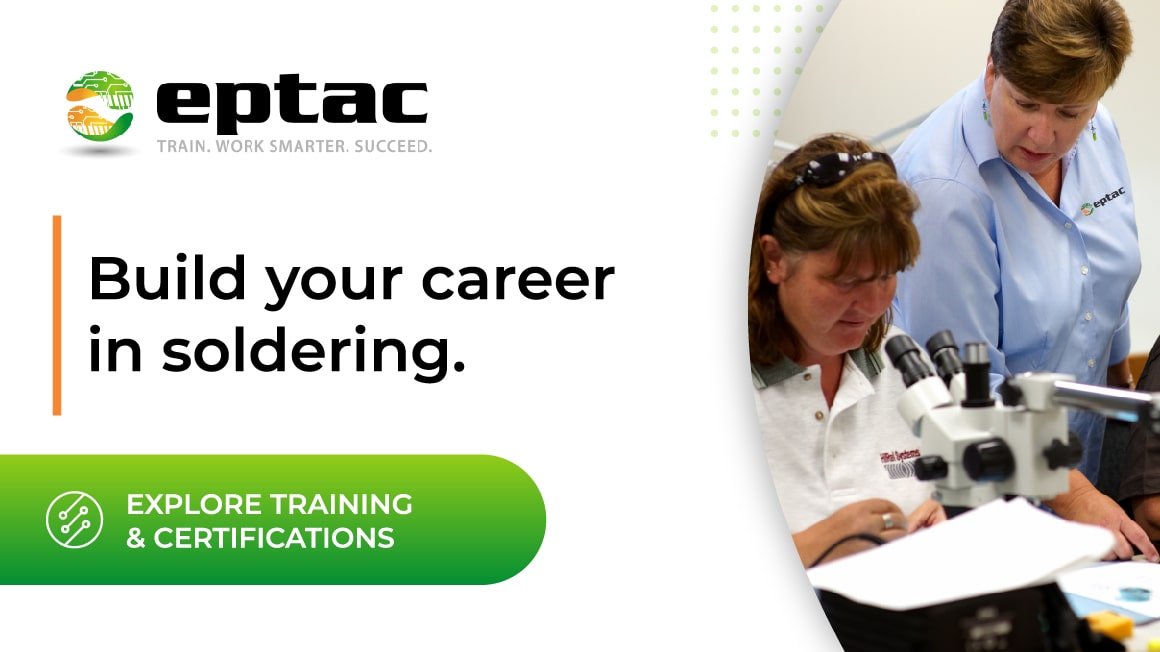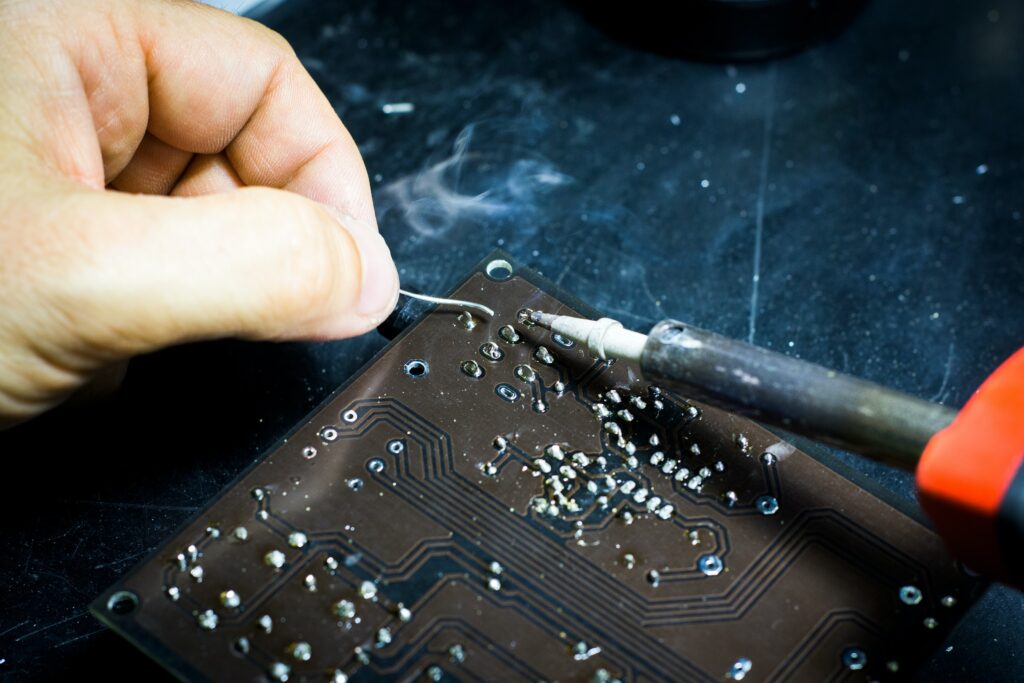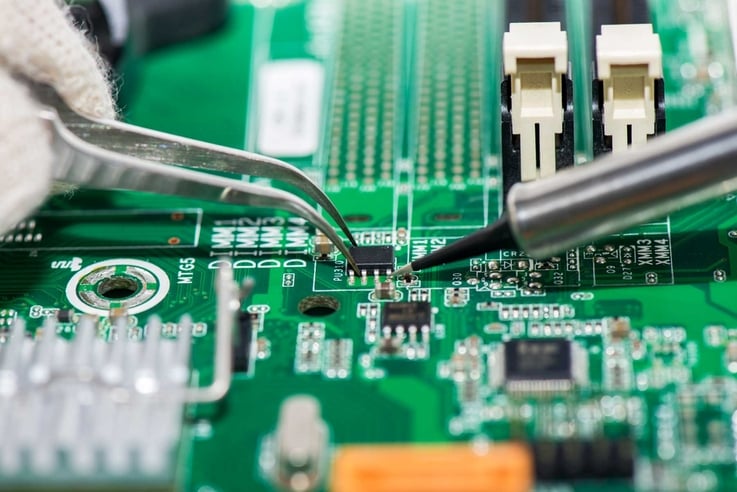Soldering is an element that is used widely throughout the electronics industry for circuit boards and in a variety of different professions. It is the joining process used to fuse different types of metals together by melting solder. Solder is a metal alloy usually constructed of tin and lead and is melted by using a hot iron.
The hot iron is heated to temperatures above 600 degrees Fahrenheit, which eventually cools and creates a strong electrical bond. When soldering, it is crucial to have the essential tools you need in order to produce a successful product. Let’s explore 5 of those essential tools.
Solder
Solder is essential to any soldering project or application because it is the filler material that melts and joins the two materials together. Keep in mind that the solder should have a lower melting point than the materials that are being joined.
This will allow the solder to melt first and bond the materials together for a solid solder joint. Solders can be made with or without lead, and based on what kind of materials you’ll be soldering, solder with a lower melting point is the best.
Soldering Iron
There are many types of soldering irons. For most projects, it is essential to use a pencil-style soldering iron because they allow you to solder small connections and components without having to use an expensive, bulky tool or station.
When using a pencil-style soldering iron, it is recommended that it is 25 watts or more. Using an under-powered iron, less than 25 watts, will cost you more in the long run due to ruined products and damaged components.
Under-powered irons also take longer to heat the joint, potentially overheating the component being soldered and causing damage. A soldering pencil is used for soldering small metallic elements and electrical components.
The finer point helps with detailed and microscopic works. Soldering tips could also help with precise, detailed work as they come in several different shapes and sizes, suitable for many types of soldering. Just remember that cleaning the tip after each session is important.
Two Common Types of Soldering Irons
Pencil-style Soldering Irons:
Pencil-style soldering irons are perhaps the most common type found in electronics workshops and toolboxes. Their slender design resembles that of a pencil, hence the name. These irons offer precision and control, making them ideal for intricate soldering tasks such as surface mount soldering and fine-pitch component soldering.
Stationary Soldering Irons:
Stationary soldering irons, also known as soldering stations, feature a base unit connected to a handheld iron via a flexible cord. These irons are equipped with temperature controls, allowing users to adjust the heat output according to the requirements of the soldering task. Stationary irons are favored for their versatility and consistent performance, making them suitable for a wide range of soldering applications.
Importance of Quality Soldering Irons
Investing in high-quality soldering irons and soldering iron kits is essential for achieving reliable solder joints and ensuring the longevity of electronic assemblies. Cheap or low-quality soldering irons may lack temperature control, leading to overheating and damage to sensitive components. Additionally, inferior soldering irons may have poor heat transfer properties, resulting in inconsistent solder joints and soldering defects.
Soldering Iron Kits: A Comprehensive Solution
Soldering iron kits offer a convenient solution for professionals, bundling essential soldering tools and accessories into a single package. These kits typically include a soldering iron, solder wire, soldering wick, flux, and various soldering tips. By purchasing a soldering iron kit, users can ensure they have all the necessary tools to tackle a wide range of soldering tasks effectively.
Soldering Wick
Nobody is perfect, and mistakes are bound to happen. That’s where the soldering wick comes in. A soldering wick serves as a de-soldering tool. It’s made by intertwining copper wires together. These wires, when heated, allow you to make alterations to joints you have already soldered.
When placing the tip of the soldering wick to heat, the wick melts the solder and absorbs it. Once the portion of the soldering wick is covered with solder, it will need to be removed and repeated until all the solder is gone.
Magnifying Glass
Soldering requires a high level of precision that is not possible with just the naked eye. It is essential to have a magnifying glass, microscope, or some sort of magnification device on hand in order to see your electronic component’s parts clearly.
This way, you can help minimize mistakes and have higher-quality finished projects. Here are a few different magnifying glasses that are beneficial for soldering.
Soldering Helping Hands
The helping hands magnifying glass has hand-like crutches that can hold wires when you are soldering. Some can have two hands, and some may have four, depending on the model and your preference. You can also use the hands to place the soldering iron you’re working on.
Magnifying Goggles
You can also wear magnifying goggles efficiently around your head when soldering. Some even come with a built-in LED light. While some offer 5 or 6 LEDs, there are some that offer 30 or 40 LEDs for excellent lighting along with high magnification.
Wire Cutters
When soldering, you’ll be working with numerous wires that’ll need to be cut once finished, especially when soldering electrical wires. Wire cutters are very handy tools and can be used to cut along the component’s leads or to strip the end of a wire you were using.
With any soldering, it is essential to use your resources. There are many different standards and manuals, training kits and aids, and certifications that will help your soldering process.
EPTAC holds numerous soldering certification courses, including Advanced Micro SMT Hand Soldering, Hand Soldering Certification, and J-STD-001 Instructor, Specialist, and Standard Expert training. All taught by experts who know the industry inside and out. Further your education in soldering with one of EPTAC’s training courses today.

About EPTAC
EPTAC is an internationally recognized leader in solder training and IPC certification, providing professionals with the skills to accelerate their careers and businesses and the talent to succeed. For over 35 years, EPTAC has been helping corporations increase quality standards, improve productivity, and maximize profits.
With 24 locations in North America, EPTAC continues to expand its offerings and exceptional instructional staff to provide easy access to knowledge and skill-based programs when and where the industry demands it. Access our scheduled programs through our website or schedule your own corporate on-site training. For more information, call 800.643.7822 or contact us.





.jpeg)
